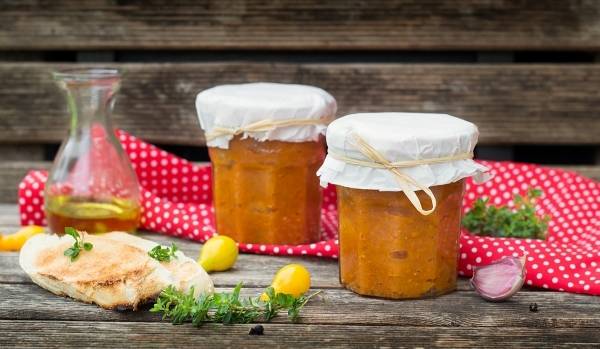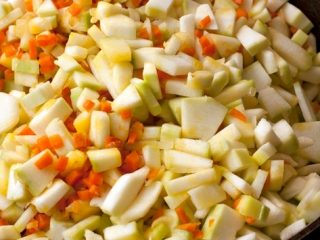Among the total shortage of food products in the Soviet Union, there were certain names of products that not only could be found on the shelves in almost any store, but they also had a unique taste. These products include canned food called squash caviar. By the way, at its price it was accessible to everyone. Zucchini caviar, like in the store, is still remembered due to its taste, which cannot be surpassed even by homemade caviar, which is prepared from fresh, young zucchini collected in one’s own garden. Many people, in an attempt to restore the same taste of caviar, have tried many recipes, but in vain. The caviar that is now sold in stores cannot compare, according to experts, with caviar from Soviet-era zucchini. Some, trying to recreate that same taste, find caviar recipes according to GOST, but even in this case, many do not always get the original taste.
What is the mystery here?
Main components of squash caviar
First of all, it is worth noting that the GOST did not specify the recipe or technology for preparing squash caviar. This document usually addressed the requirements for the quality of initial and final products, packaging, storage conditions, and more.Thus, GOST 51926 -2002 describes all the above-mentioned characteristics that are relevant to the production of any vegetable caviar. And specific recipes and technological processes were usually described in detail in special documents.
To best answer the question, how to cook squash caviar according to GOST, it is necessary, first of all, to consider what real zucchini caviar should consist of. Below is a table in which all the main components of caviar are given as percentages in relation to the total volume of the finished dish.
Components | Percentage |
|---|---|
Fried zucchini | 77,3 |
Fried carrots | 4,6 |
Roasted white roots | 1,3 |
Fried onions | 3,2 |
Fresh greens | 0,3 |
Salt | 1,5 |
Sugar | 0,75 |
Ground black pepper | 0,05 |
Ground allspice | 0,05 |
Tomato paste 30% | 7,32 |
Vegetable oil | 3,6 |
As can be seen from the table, the composition zucchini caviar includes white roots and greens. It is these components that are usually rarely used when making caviar at home. But it is the white roots, and even fried in oil, that give zucchini caviar that amazing, barely perceptible mushroom taste and aroma, which, apparently, added zest to the taste of store-bought caviar of ancient times. The white root recipe included parsnip, parsley root and celery root. Moreover, parsnip in its percentage content was twice as high as parsley and celery. The greens included in the squash caviar consisted of leaf parsley, dill and leaf celery. At the same time, the content of parsley was twice as high as dill and celery.
For those who find it difficult to convert the percentage of components into real weight values, below is the amount of product in grams that must be taken to prepare caviar according to GOST, for example, from 3 kg of zucchini:
- Carrots – 200 g;
- White roots -60 g (parsnips -30 g, parsley root and celery root 15 g each);
- Onions -160 g;
- Greens – 10 g (parsley -5 g, dill and celery 2.5 g each);
- Salt – 30 g;
- Sugar – 15 g;
- Ground black and allspice pepper 1 g each;
- Tomato paste 30% – 160 g;
- Vegetable oil – 200 ml.
It is necessary to understand that all weight characteristics are given in the recipe for vegetables fried in oil. Therefore, if initially most vegetables were taken by weight in their raw form, then since they will decrease in weight after frying and stewing, the amount of salt, sugar and tomato paste will also need to be reduced somewhat. Because these three components are placed last in the manufacturing process.
This point is very important. Because when you prepare caviar from zucchini according to GOST, you need to choose the largest, fully ripe fruits, with hard seeds and peel. It is their pulp that has the richest taste, which is transferred to the finished dish.
Cooking technology
Since mature zucchini is used to prepare caviar, at the first stage it is necessary to peel off the skin and remove all the seeds. The remaining pulp is cut into small pieces, no more than 1-2 cm in length.
Carrots and onions are peeled and cut into small cubes; the white roots can be grated or chopped in any convenient way, since they can be quite hard and sticky.
Oil is poured into a frying pan and heated to a temperature of at least 130°, so that white smoke comes out of it, and only then the pieces of zucchini are fried in it until golden brown. If there is a lot of zucchini, it is better to fry it in batches to improve the quality and taste. Place the fried zucchini in another frying pan, add a few tablespoons of water, and simmer until tender (softened).
Cooked and chopped other vegetables (carrots, white roots and onions) are fried sequentially in the same frying pan where the zucchini was fried before. Then water is added to them, and they are also stewed until fully cooked.
Interestingly, when making squash caviar, as in the store, using GOST rules, there is not much difference in whether the vegetables are fried separately or all together. Both options are allowed. But vegetables fried separately from each other have a richer taste.
The next step is to combine all the vegetables together and chop them using a blender or food processor. Then they are placed in a saucepan with a thick bottom and placed on fire. Tomato paste and finely chopped herbs are added to the zucchini caviar and everything is boiled for 15-20 minutes with mandatory stirring.At the last stage, add salt, sugar and both types of pepper to the pan and boil the caviar for another 10 minutes until the spices are completely dissolved.
If you think that the caviar is too thin and are thinking about how to make it thicker, then you can use the following option. Heat a few tablespoons of wheat flour in a dry frying pan until golden brown. Gradually add the resulting flour to the finished caviar, constantly stirring and continuing heating.
While still hot, the caviar must be placed in small sterilized jars (preferably no more than 0.5 liters in volume) and sterilized for about 40-45 minutes. Roll up with sterilized lids, turn over, wrap and leave to cool in this form for a day.
It must be taken into account that the real taste of store-bought squash caviar according to GOST is obtained only after the product has completely cooled, after about 24 hours. Therefore, it is advisable to first set aside a certain amount in order to be able to try it in a day. If you are completely satisfied with the taste, then you can prepare larger quantities of this recipe for the winter.
Preparing caviar from zucchini according to this recipe is not so difficult, but you will get the taste of a product that the older generation, who grew up in the Soviet era, remembers. And there was something special about him, if many still cannot forget him.
















